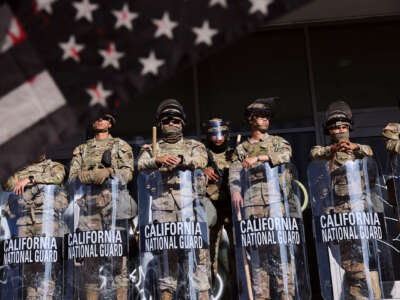When did the act of public protest — a right protected by the First Amendment — become an act of “rebellion” eliciting a military response? What began as a fairly small protest against an Immigration and Customs Enforcement (ICE) raid at an apparel manufacturer in the Fashion District in downtown Los Angeles on June 6, led to an immediate response by federal agents in riot gear using pepper spray and “nonlethal bullets” to clear a path for vans to leave with detainees. This response in turn led to a larger mobilization that evening at the Los Angeles Federal Building downtown, demanding an end to all ICE raids in the city. By Saturday, June 7, as protests continued to grow, the LAPD declared all assembly in downtown Los Angeles illegal, and President Donald Trump, against the wishes of the California government, called in the National Guard, leading to violence, tear gas, and arrests.
This coordinated repression did not come from nowhere. In 2024, The New York Times reported that the Trump transition team was already planning to use emergency powers, such as the one Trump invoked on June 7, to confront political opponents who protest the administration. While the Trump administration planned this move for about a year, the deployment of troops in Los Angeles is the brutal culmination of a yearslong campaign to systematically erode and circumscribe public assembly rights, enabled by both Democrats and Republicans at all levels of government. Political scientists call this “democratic backsliding”: the gradual erosion of basic rights, civil liberties, and other political institutions that allow the public to hold the government to account. This war on dissent is the most visible sign of democratic backsliding in the U.S. By using the National Guard to silence dissent in Los Angeles, the Trump administration is eroding a core pillar of democracy: the right to assemble in public to express opinions contrary to government action and to advocate for change.
The recent developments in Los Angeles suggest new trends in the logic of protest policing. During the civil rights movement, in which police faced strong backlash when they clashed violently with activists, U.S. police forces developed a new approach to public order policing called “negotiated management” in the 1980 and 1990s. Under negotiated management, police tried to respect the right of public assembly during large-scale public demonstrations to minimize clashes between protesters and police. However, in response to the anti-globalization protests at the 1999 World Trade Organization meeting in Seattle, during which organizers refused to meet with police, police shifted to a new set of tactics called “strategic incapacitation” that would provide them with more control. This harsher and more repressive model aims to prevent protesters from engaging in serious public disruption (such as stopping traffic) by carefully containing protests — and in some cases, using aggressive tactics, such as penning protesters, mass arrests, and dispersal of protests through “nonlethal” chemical agents and rubber bullets to prevent large-scale protests from even taking place.
Strategic incapacitation was presented as a combination of technologically advanced and “humane” tactics, given police use of “nonlethal” tools. But in fact, Anna Feigenbaum at University of Glasgow and author of Tear Gas, told Truthout: “Tear gas is promoted as a ‘nonlethal’ form of crowd control, but in fact often causes harm, including serious injuries and even deaths. The use of these weapons by police and National Guard to suppress protests is often indiscriminate and dangerous.”
In the post-9/11 security state, the police also found themselves with more resources and political power. As a result, police combine these new tactics with advances in technology to disrupt protests through surveillance and even pre-emptive arrests.
However, the events in Los Angeles appear to be moving beyond the control, surveillance, and use of technology that makes up strategic incapacitation. Instead, Trump’s federal overreach suggests the beginnings of a newer, even more sinister form of public order policing.
Reflecting on the current situation, Daniel Edler, research associate at the State University of Rio de Janeiro, told Truthout: “For me, what’s happening in LA is nothing like that. Maybe the LAPD tried to apply strategic incapacitation, but if so, it clearly failed. I’d characterize the use of the National Guard and Marines as a return to ‘escalated force,’ similar to the violent scenes in the 1950s and 1960s in Selma.”
This trend toward a newer and more repressive form of public order policing is not solely a Trump innovation. Democratic Party presidencies deployed these tactics against major protest movements, such as Occupy Wall Street, the climate change movement, and the campus protests against the War in Gaza. And the Trump administration in its first term supported similar tactics to crack down on the Black Lives Matter uprising in 2020 — the largest nonviolent mass protest movement in U.S. history.
In addition to this shift in police tactics, successive governments at all levels in the U.S. have developed a legal and rhetorical toolkit to justify authoritarian response to dissent. The right-wing lobbying group ALEC has spent the last decade encouraging state legislatures to rewrite anti-riot laws so that common nonviolent protest tactics, such as blocking roads and locking oneself onto fixed objects, are classified as acts of rioting, and can lead to felony charges.
Trump administration has been testing the legal and political limits of its capacity to use the state to crush political opposition. With that precedent in place, the administration is now escalating this repression.
Rhetorically, politicians try to equate traditional nonviolent protest tactics with actions by lawless mobs. During the campus protests against Israel’s war in Gaza in the spring of 2024, President Joe Biden condemned student protesters and justified their repression by arguing that they were not “peaceful” — despite minimal accounts of physical violence by protesters, and negligible accounts of property damage.
While classic proponents of nonviolent civil disobedience, such as Martin Luther King Jr. and Mohandas Gandhi, have preached the need for nonviolent direct action, they also understood that protest required activists to disturb the peace, to stage a confrontation, in order to make an injustice manifest, and pressure authorities to change course. By blurring the distinction between disruptive nonviolent actions and violence, Biden paved the way for the authoritarian oppression by the Trump administration that we are witnessing today.
Since returning to office in January, the Trump administration has progressively ramped up its tools for silencing dissent. One of its very first targets were international students on U.S. college campuses who had participated in protests against the war in Gaza. ICE arrested these protesters, often without due process, as a means to both target universities that the Trump administration perceived as political enemies, and with an eye toward removing potential leaders of an opposition movement from the U.S. Again, this repeats the pattern of “strategic incapacitation,” whereby police target leaders of protest movements to prevent future demonstrations from taking place. By weaponizing the bureaucratic power of the Office of Homeland Security to revoke visas of political opponents, the Trump administration has been testing the legal and political limits of its capacity to use the state to crush political opposition. With that precedent in place, the administration is now escalating this repression. The tactics used against foreign students are now being directed towards another vulnerable group: undocumented migrants, and their political supporters.
By beginning with vulnerable groups who have less legal standing and social capital to resist repression, the Trump administration is making a strategic choice, hoping to provoke less public outcry and then use these precedents of repression later against a broader population. This is a textbook example of democratic backsliding, similar to what we have witnessed in countries, such as Poland and Hungary, in recent years. The government targets marginalized groups and unpopular causes to establish the precedent of undermining public assembly rights. Once the practice is normalized, it is then deployed against broader segments of the public.
The Trump administration has shifted from bureaucratic threats to armed suppression of political opponents.
Over time, the government chips away at the right to public assembly. This is dangerous for three reasons: First, the right to protest is not a favor granted by the state; it is a basic right to check the state’s power. When government represses expressions of dissent via the National Guard, the government is signaling that it is no longer accountable to the people, and that it is willing to counter dissent with force. Second, these moves use fear to demobilize opposition. The image of the National Guard being deployed against protesters signals to citizens that the cost of speaking out has risen significantly. Democracy is eroded not through a violent explosion, but through the quiet (and often rational) decision by millions of citizens to stay home. Third, repressing dissent in this way breaks a basic democratic feedback loop. Protest is essential to a democracy. It is a real-time barometer of public discontent that holds governments to account between infrequent elections. To crush dissent in this way, the Trump administration (already historically unpopular in public opinion polling) is signaling that it has no interest in listening to dissenting opinions, but only to stamp dissent out.
The soldiers on the street of Los Angeles have laid the stakes bare. We are witnessing a crisis in U.S. democracy. The Trump administration has shifted from bureaucratic threats to armed suppression of political opponents. We must choose what we find more dangerous: the inconvenience of a blocked street and a noisy protest, or the convenience of a silent street and a docile public. The former is the messy and uncomfortable sound of a thriving democracy. The latter is the quiet, orderly silence of an authoritarian state. This is no time to stay at home. We must take to the streets and demand that elected officials at every level of government condemn the use of military and police force against protesters.
Keep the press free. Fight political repression.
Truthout urgently appeals for your support. Under pressure from an array of McCarthyist anti-speech tactics, independent journalists at Truthout face new and mounting political repression.
We rely on your support to publish journalism from the frontlines of political movements. In fact, we’re almost entirely funded by readers like you. Please contribute a tax-deductible gift at this critical moment!
Read full article at source
Stay informed about this story by subscribing to our regular Newsletter


